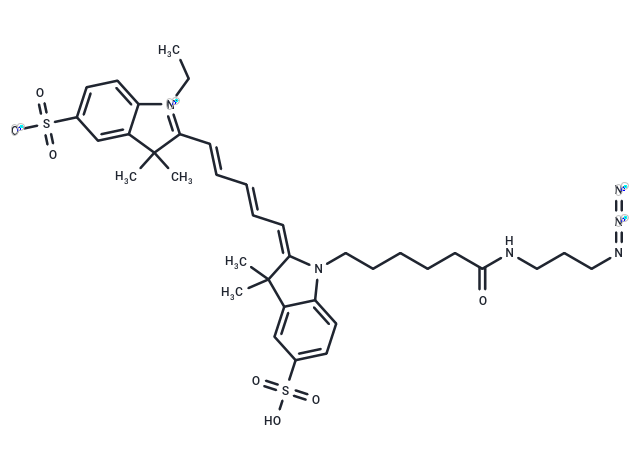Shopping Cart
Remove All Your shopping cart is currently empty
Your shopping cart is currently empty
CY5-N3 (Sulfo-Cyanine5-azide) is an anthocyanin fluorescent dye with azide groups, utilized for cell imaging, tissue imaging, and in vivo imaging.

| Pack Size | Price | USA Warehouse | Global Warehouse | Quantity |
|---|---|---|---|---|
| 1 mg | $112 | In Stock | In Stock | |
| 5 mg | $266 | - | In Stock | |
| 10 mg | $413 | - | In Stock | |
| 25 mg | $747 | - | In Stock | |
| 50 mg | $1,120 | - | In Stock |
| Description | CY5-N3 (Sulfo-Cyanine5-azide) is an anthocyanin fluorescent dye with azide groups, utilized for cell imaging, tissue imaging, and in vivo imaging. |
| Cell Research | Instructions I. Solution preparation 1. Stock solution: Dissolve CY5-N3 in DMSO, DMF or appropriate buffer. Common stock solution concentration: 1–10 mM. Store at -20°C in the dark to prevent photodegradation and degradation. 2. Working solution: Dilute the stock solution to the desired concentration (e.g. 0.1–10 µM) with an appropriate buffer (e.g. PBS or HEPES buffer, pH 7.2–7.4). Prepare fresh to ensure the best results. II. Bioorthogonal labeling using CY5-N3 1. SPAAC labeling protocol (copper-free click chemistry): Prepare functionalized target biomolecules (e.g. DBCO-modified proteins, peptides or nucleic acids). Mix CY5-N3 with the target molecule at the desired concentration (e.g. 1–10 µM) and incubate in a reaction buffer (e.g. PBS, pH 7.4). Usually incubate for 30 minutes to 2 hours at room temperature. 2. CuAAC labeling protocol (copper-catalyzed click chemistry): 1) Add a small amount of copper (such as CuSO₄ and a reducing agent such as ascorbic acid) to the reaction system. 2) Mix CY5-N3 with a biomolecule with an alkyne group and place it in a reaction buffer (such as PBS or Tris-HCl, pH 7.4). 3) Incubate at room temperature for 30–60 minutes with appropriate stirring. 4) Purify the labeled biomolecule using molecular sieve chromatography, ultrafiltration or similar methods to remove unreacted dye. 3. Imaging applications Cell imaging: (1) Label live or fixed cells by using CY5-N3-labeled biomolecules or directly in SPAAC/CuAAC labeling. (2) Wash cells with PBS to remove unbound dye. (3) Analyze the fluorescence signal using a confocal microscope or fluorescence microscope, and select a filter set suitable for CY5 (excitation wavelength: approximately 646 nm, emission wavelength: approximately 662 nm). Tissue imaging: (1) Stain tissue sections with CY5-N3-labeled probes. (2) Wash sections thoroughly to remove background fluorescence. (3) Analyze using a fluorescence microscope or whole-slice imaging system. In vivo imaging: (1) Inject CY5-N3-labeled probes into animal models. (2) Perform near-infrared fluorescence imaging using an in vivo imaging system (such as IVIS) or similar platform. (3) Monitor the distribution, targeting, and clearance of labeled probes. Precautions 1. Photosensitivity: CY5-N3 is light-sensitive. Avoid long-term exposure to light and store in a dark place. 2. Reaction optimization: Optimize dye concentration, reaction time, and buffer conditions to achieve efficient labeling and reduce background. 3. Copper toxicity (for CuAAC): Copper ions may affect biological samples, so the copper concentration should be carefully controlled, or SPAAC should be selected for copper toxicity issues. 4. Stability: The stock solution should be aliquoted to avoid repeated freezing and thawing to maintain the activity of the solution. |
| Synonyms | Sulfo-Cyanine5-azide |
| Molecular Weight | 738.92 |
| Formula | C36H46N6O7S2 |
| Cas No. | 1621101-43-6 |
| Smiles | CC[N+]1=C(\C=C\C=C\C=C2\N(CCCCCC(=O)NCCCN=[N+]=[N-])c3ccc(cc3C2(C)C)S(O)(=O)=O)C(C)(C)c2cc(ccc12)S([O-])(=O)=O |
| Relative Density. | no data available |
| Storage | store at low temperature,keep away from direct sunlight,keep away from moisture,The compound is unstable in solution. Please use soon | Powder: -20°C for 3 years | In solvent: -80°C for 1 year | Shipping with blue ice/Shipping at ambient temperature. | |||||||||||||||||||||||||
| Solubility Information | DMSO: 20 mg/mL (27.07 mM), Sonication is recommended. | |||||||||||||||||||||||||
Solution Preparation Table | ||||||||||||||||||||||||||
DMSO
| ||||||||||||||||||||||||||
| Size | Quantity | Unit Price | Amount | Operation |
|---|

Copyright © 2015-2025 TargetMol Chemicals Inc. All Rights Reserved.